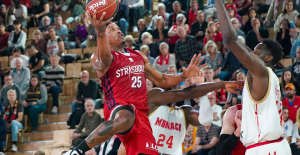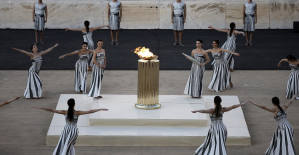The pictures on the fence at the Überseebrücke show what journey the Sea Watch 5 will soon await. Printed out rescue scenes can be seen: stranded people in orange inflatable boats, exhausted rescued people on deck, worried helpers. Behind the fence, opposite Cap San Diego, rises the rescue ship, 12 years young, 58 meters long: it is said to be faster, larger and more efficient than all of its predecessor ships.
It cost a whopping 4.5 million euros in donations. The money came in particular through the “United4Rescue” alliance set up by the Evangelical Church in Germany (EKD). It brings together more than 850 organizations and groups that are committed to sea rescue in the Mediterranean. In the coming months, the ship will be converted into a refugee ship in Hirtshals and Flensburg, Denmark. The deck on which the rescued are accommodated gets a new floor and rain cover. The activists want to set off on a rescue mission in the Mediterranean for the first time in the new boat as early as March. The baptism was on Thursday.
"This ship will also save lives," said Christian Stäblein, the so-called EKD refugee bishop. "Together with many other organizations, we oppose the deadly isolationist policy of the EU member states with our humanity, solidarity and charity," said the bishop. Sea rescue is a humanitarian duty and a primal Christian task. Synod President Anna-Nicole Heinrich said that the alliance ship is "floating proof" of how much the church can achieve when it enters into strong networks with other organizations and partners.
According to the EKD, more than 25,000 people have drowned in the Mediterranean since 2014, and the number of unreported cases is likely to be significantly higher. This year alone, the International Organization for Migration (IOM) counts 1,765 victims. The Italian rescue mission Mare Nostrum ended in 2014, organizations like Sea Watch, which was founded in 2015, want to fill this gap with civil sea rescue. Again and again, the activists come into conflict with laws and government agencies. Italy, for example, repeatedly denies access to ports.
Around 31 crew members are to accompany a mission, nautical specialists, doctors, but also volunteers, kitchen and auxiliary staff. "There is space on deck for about 400 to 500 rescued people," says Mattea Weihe, a Sea Watch spokeswoman. The “guests”, as the group calls the people rescued from the sea, are then to be taken care of on the aft deck, protected from the sun by a canopy. Gray supply containers are one level higher. Two speedboats are also available to rescue people.
As expected, it is very cramped on deck, there are small cabins with bunk beds, a so-called “recovery area”, i.e. a convalescence area especially for women and children. According to spokeswoman Weihe, they often sit on board the smuggler boats in the middle and not on the outside. A well-intentioned approach, they would be shielded against the waves. In the middle, however, a caustic mixture of faeces, salt water and petrol often collects. As a result, many of the women and children suffered from burns and would first have to be given extensive care after being rescued. On that day, it was not yet clear who would be the captain of the Sea Watch 5 on the first mission. At the weekend (November 5-6), the ship can be viewed at the Hamburg Überseebrücke.
While helpers are getting ready for a rescue mission, more and more refugees are coming to the Hamburg aid system. This year, the number of arrivals is already higher than in the year of the so-called refugee crisis in 2015, the social security authority recently announced. "In 2015, a good 43,100 people came," said spokesman Martin Helfrich. This year there are already 46,700 refugees. Not all people would stay in the Hanseatic city, but would continue to travel or be distributed, some had also traveled back again.
But according to the authorities, the city had to provide accommodation for a good 15,500 people this year - in 2015 there were 21,000 have to be accommodated,” said Helfrich. "These plans were all activated after the outbreak of war in Ukraine."
However, the capacities were not sufficient. "No plan can completely take into account such eventualities as the outbreak of war on European soil," stressed Helfrich. Among other things, refugees are currently being accommodated in 62 Hamburg hotels.
Everywhere in the city, the staff office is looking for refugees and the municipal provider is looking for funding

 War in Ukraine: when kyiv attacks Russia with inflatable balloons loaded with explosives
War in Ukraine: when kyiv attacks Russia with inflatable balloons loaded with explosives United States: divided on the question of presidential immunity, the Supreme Court offers respite to Trump
United States: divided on the question of presidential immunity, the Supreme Court offers respite to Trump Maurizio Molinari: “the Scurati affair, a European injury”
Maurizio Molinari: “the Scurati affair, a European injury” Hamas-Israel war: US begins construction of pier in Gaza
Hamas-Israel war: US begins construction of pier in Gaza First three cases of “native” cholera confirmed in Mayotte
First three cases of “native” cholera confirmed in Mayotte Meningitis: compulsory vaccination for babies will be extended in 2025
Meningitis: compulsory vaccination for babies will be extended in 2025 Spain is the country in the European Union with the most overqualified workers for their jobs
Spain is the country in the European Union with the most overqualified workers for their jobs Parvovirus alert, the “fifth disease” of children which has already caused the death of five babies in 2024
Parvovirus alert, the “fifth disease” of children which has already caused the death of five babies in 2024 Inflation rebounds in March in the United States, a few days before the Fed meeting
Inflation rebounds in March in the United States, a few days before the Fed meeting Video games: Blizzard cancels Blizzcon 2024, its annual high mass
Video games: Blizzard cancels Blizzcon 2024, its annual high mass Falling wings of the Moulin Rouge: who will pay for the repairs?
Falling wings of the Moulin Rouge: who will pay for the repairs? “You don’t sell a company like that”: Roland Lescure “annoyed” by the prospect of a sale of Biogaran
“You don’t sell a company like that”: Roland Lescure “annoyed” by the prospect of a sale of Biogaran Exhibition: in Deauville, Zao Wou-Ki, beauty in all things
Exhibition: in Deauville, Zao Wou-Ki, beauty in all things Dak’art, the most important biennial of African art, postponed due to lack of funding
Dak’art, the most important biennial of African art, postponed due to lack of funding In Deadpool and Wolverine, Ryan and Hugh Jackman explore the depths of the Marvel multiverse
In Deadpool and Wolverine, Ryan and Hugh Jackman explore the depths of the Marvel multiverse Tom Cruise returns to Paris for the filming of Mission Impossible 8
Tom Cruise returns to Paris for the filming of Mission Impossible 8 Skoda Kodiaq 2024: a 'beast' plug-in hybrid SUV
Skoda Kodiaq 2024: a 'beast' plug-in hybrid SUV Tesla launches a new Model Y with 600 km of autonomy at a "more accessible price"
Tesla launches a new Model Y with 600 km of autonomy at a "more accessible price" The 10 best-selling cars in March 2024 in Spain: sales fall due to Easter
The 10 best-selling cars in March 2024 in Spain: sales fall due to Easter A private jet company buys more than 100 flying cars
A private jet company buys more than 100 flying cars This is how housing prices have changed in Spain in the last decade
This is how housing prices have changed in Spain in the last decade The home mortgage firm drops 10% in January and interest soars to 3.46%
The home mortgage firm drops 10% in January and interest soars to 3.46% The jewel of the Rocío de Nagüeles urbanization: a dream villa in Marbella
The jewel of the Rocío de Nagüeles urbanization: a dream villa in Marbella Rental prices grow by 7.3% in February: where does it go up and where does it go down?
Rental prices grow by 7.3% in February: where does it go up and where does it go down? Even on a mission for NATO, the Charles-de-Gaulle remains under French control, Lecornu responds to Mélenchon
Even on a mission for NATO, the Charles-de-Gaulle remains under French control, Lecornu responds to Mélenchon “Deadly Europe”, “economic decline”, immigration… What to remember from Emmanuel Macron’s speech at the Sorbonne
“Deadly Europe”, “economic decline”, immigration… What to remember from Emmanuel Macron’s speech at the Sorbonne Sale of Biogaran: The Republicans write to Emmanuel Macron
Sale of Biogaran: The Republicans write to Emmanuel Macron Europeans: “All those who claim that we don’t need Europe are liars”, criticizes Bayrou
Europeans: “All those who claim that we don’t need Europe are liars”, criticizes Bayrou These French cities that will boycott the World Cup in Qatar
These French cities that will boycott the World Cup in Qatar Basketball: Strasbourg appeals the victory recovered by Monaco
Basketball: Strasbourg appeals the victory recovered by Monaco Top 14: UBB with Tatafu and Moefana against Bayonne
Top 14: UBB with Tatafu and Moefana against Bayonne MotoGP: Bagnaia dominates qualifying practice in Spain and sets track record
MotoGP: Bagnaia dominates qualifying practice in Spain and sets track record Olympic Games: in Athens, Greece transmits the Olympic flame to France
Olympic Games: in Athens, Greece transmits the Olympic flame to France


















